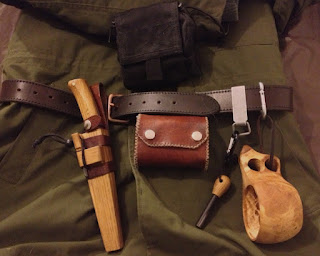YeeHaaa!! I got
Tagged!! by Perkunas of
Perkele´s Blog on the Topick of
"My three favorite bushcraft/camping items"
My three favorite items.... when I accepted this tagging, I started to think of what would be my favorite? I do not own so many of gears and items, and I do use and like all of them. Of cause, some are used little more than others, but I only get what I really want or like. so it is difficult to pic just three. so I decided to divide my gears in 4 categories.
Shelter - Carrying - Cooking - Cutting
- Shelter would include clothing, tarp, tents and those accessories. Among those, there are few items rises as "favorite", like Sasta shirts, Rain camo shirts, Czech cadet parka and so on. (no, I do not have favorite tent/tarp yet as I am still experimenting what works the best.) but none of them are as strong as to pick as one of the three. if it is to pick four, then Rain camo shirts might enter...
- So move on to "Carrying" equipment. the back packs pouches and side bags. All are used quite equally, but none stands out. that is because I choose them as I feel like or amount need to carry.
but then this one item suddenly stood out...
"Belt"
I know I know.. it is a belt, Nothing fancy... but think about it. how many of you do not use belt? Think of what it can do? Why not pay attention to the belt?
Belt is something we use every day and holds your pants up :) also used very commonly to carry small items accessible. Tightens your winter jacket so cold air does not enter up. It has been an accessory of a man since god knows how long.
On top of that, the one I got is quite special one. It is hand made by local shoe maker and is made from 5mm thick, super durable leather. No one makes belt with 5mm leather except the one for weight lifting belt. Also this one got copper belt buckle, not brass.
I use it with several belt clips and carabinas for hanging points. dump pouch and fire kit could join there time to time and of cause the knife.
- Cooking includes all kind of pots, fire making and water carrying items. Piking one from this group was easiest task. my favorite canteen set of
“Swiss canteen M32”
It is a Swiss army surplus from 70s’ to 80s’. 600ml of capacity in oval shaped aluminium bottle and cup. I just love this shape and looks. The capacity is little small, but just enough for few hours hike in forest to have cup of coffee. For longer trip, I use this as on go water bottle. Carry it in my dump pouch so I have easy access to water when walking. Oval cup helps easy refilling of bottle and also I use it often to brew coffee on spirit stove.
- Then come to Cutting category.
If you ask what is my favorite cutting tool? Then answer would be "Axe". but I do not have any one particular axe which I favor the most. Axe is my favorite as in general, so not picking one in here...
So, I need to pick one from my knives...
"Self-made Wood working Puukko"
I have made this knife because I needed some wood working specific knife. but when I have started to use, it proven to be a very comfortable one to carry also in the woods. It handles the curving work comfortably, can process woods for fire, can make tools from woods. it is not exactly batoning friendly when comes to baton thick wood, but then I usually carry an axe for that job.
even thaw this is the first choice of knife, lately I am considering of upgrading it. It is because I wont the one I carry to be a signature. I wont it to tell that the knife belongs to me or the people remembers me because of the knife. Well, that is bit of fantasy, but would be wonderful.
So, here it is "My Three Favorite Items"
Hope this tell bit about me and how I think of my gears. This post became little longer than I have anticipated, but I do care for every one of my gears so it is the refection of that.
all of them are passing by on my possession, it come and goes soon or later. But I would like to think all the items are "Treasure every encounter". It teaches, tells, shows, experience something to me, so I will look after them properly.
What are your favorite? why? feel free to post comment here and also track back other tagged posts on this topic to see what others are picking.
Lets pass on the tag..... upps... all the bloggers I do have closer communication are already tagged...
Well I think this is a good chance for me to get actively widening my friends. so I will tag 2 bloggers who I know (or I think) checking my blog.
Even thaw I have not commented there yet, I have been visiting his blog for quite some time now. Great Photos, Trip stories, lots of gear reviews and much more. Recently moved to new blog location to continue his great postings.
He has been very quiet lately so I hope he is still around to able to make post. However, he probably is most popular outdoors man from Asia and has great crafting and outing posts on his blog.
Hope this tagging will work out.




































